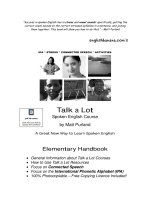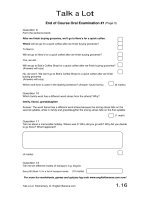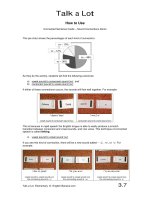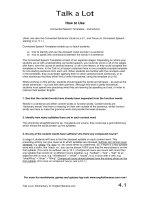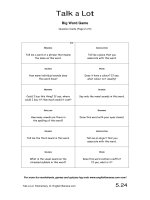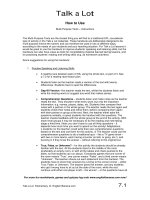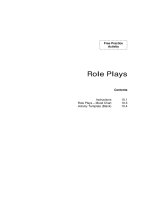Tài liệu Spoken english elementary handbook part 7 ppt
Bạn đang xem bản rút gọn của tài liệu. Xem và tải ngay bản đầy đủ của tài liệu tại đây (227.05 KB, 15 trang )
Talk a Lot
Big Word Game
Instructions
For more fun worksheets, games and quizzes log onto www.englishbanana.com now!
Talk a Lot Elementary © English Banana.com
5.9
The Big Word Game is based on either the list of 50 questions (see page 5.15), or the set of
50 cards with the same questions printed on them (see pp.5.23-5.28), to be used in
conjunction with a set of discussion word cards from any Talk a Lot topic – or any word list
that you want to study. The question cards could be laminated for durability, if possible.
There are a few different ways for you to use the questions. Here we outline some of the
methods that we like, for both competitive and non-competitive activities. No doubt you and
your students will be able to think of further variations and more ways to utilise the questions!
The first time you use this activity with your class, you may need to concept check some of
the more difficult questions to make sure that your class understands them, e.g. “How many
consonant clusters does this word contain?” This is an impossible question for a student to
answer, unless they have learned what a “consonant cluster” is! See the notes for teachers
on pp.5.17-5.19 to check what students need to know to be able to answer each question.
The following activities are ideal for use during the word focus sessions on a Talk a Lot lesson
plan; as warmers at the beginning of a lesson, or as the basis of some competitive fun at the
end of a busy lesson. It’s up to you what you want to do with them!
With grateful thanks to M. for her invaluable help and encouragement in trialling this activity,
and for providing some of the questions. Dzięki! ;o)
Competitive Game #1: Question Cards – Pairs
S
ET
U
P
:
Students work in pairs. A set of 40 discussion words (or your chosen vocabulary words) is
spread out on the table in front of them, so that they can both see all of the words. There is
also a pack of shuffled question cards face down on the table. You should use only the first
40 question cards (in black type) for competitive games, and all 50 cards (including the last
ten in blue type) for non-competitive activities. Each player has 20 tokens – or coins – which
they will use to “buy” questions during the game. (For a shorter game, they could have fewer
tokens each, and for a longer game, more.)
H
OW TO
P
LAY
:
Player A chooses a discussion word, but does not touch it or say what it is. Player B then
“buys” a question card by giving one token to their opponent.
1
To buy a question card costs
one token. Player B picks up the top card from the pack and reads out the question. Player A
has to answer truthfully about the word that they have chosen. Player B then tries to guess
the word. To have a guess costs one token. If Player B can’t guess the word, they can buy
another question for one token. This continues until they guess the word, or “give up” and
Player A reveals the word. To “give up” costs two tokens. After this, the roles are reversed
and Player B chooses a word, whilst Player A has to buy questions and guesses.
1
Or, if you are using the question list, Player A chooses a number between 1-40, which Player B reads out (i.e.
Player B cannot choose their own – perhaps easier! – question), and then tries to guess Player A’s word. Player B
still has to “buy” the question from their partner.
Talk a Lot
Big Word Game
Instructions
For more fun worksheets, games and quizzes log onto www.englishbanana.com now!
Talk a Lot Elementary © English Banana.com
5.10
W
INNING
:
The game ends when one player has used up all of their tokens. The winner is the player who
still has tokens. Therefore the winner is the person who buys the least questions and
guesses. Variation: you could agree a set time for the game – e.g. 15 minutes – and when the
time has finished, the winner is the player with the most tokens left.
B
ENEFITS
:
Both students are working with the vocabulary words and thinking about a wide range of
topics and techniques connected with word focus.
E
XAMPLE
:
Here is an example of how a game might start, using the discussion words from the
“Transport” unit in Elementary Book 1:
Player A: OK. I’ve chosen a word.
Player B: Don’t tell me!
Player A: I won’t. Don’t worry!
Player B buys a question card by giving one token to Player A.
Player B: (Reading) “Is it a phrase or a word?”
Player A: It’s a phrase.
This information eliminates all but six of the discussion words from the “Transport” unit.
Player B buys a guess by giving one token to Player A.
Player B: Is it “service station”?
Player A: No.
Player B buys a question card by giving one token to Player A.
Player B: (Reading) “Describe this word using exactly four words.”
Player A: OK. Leave your vehicle here.
Player B: Car park!
Player A: Yes. That’s right.
Player B: OK. Now I’ll choose a word.
Player B has chosen a word.
Player A buys a question card by giving one token to Player B.
[etc.]
Talk a Lot
Big Word Game
Instructions
For more fun worksheets, games and quizzes log onto www.englishbanana.com now!
Talk a Lot Elementary © English Banana.com
5.11
Competitive Game #2: Question List – Whole Class
S
ET
U
P
:
This game is played by the whole class, or a large group of people, and uses the question list
(see page 5.15) rather than the question cards.
H
OW TO
P
LAY
:
A volunteer is chosen from the group, who chooses one of the 40 discussion words (without
revealing it) as well as a number from 1-40. The teacher reads out the question from the
question list. The volunteer answers the question and the whole group have to look at the 40
words and find the answer. This continues, with each volunteer choosing three or four words,
before the next student is picked. This could be used as a fun warmer at the beginning of a
lesson, or as a short “time-filler”, or a wind-down, at the end of a lesson. It could be made
more competitive by dividing the class into teams and giving points to each team when they
correctly identify the word – not to mention offering prizes for the winning team, and forfeits
for the losers, e.g. wipe the board!
W
INNING
:
The first team to 10 / 20 / 30 etc. wins. Or, within a time limit, the team with the most points at
the end wins.
B
ENEFITS
:
It’s a fun and noisy group activity which everybody can play. Students will explore a variety of
word focus themes from the Talk a Lot course, as well as continue to focus on the discussion
words from the lesson or topic that they happen to be studying at that time.
Competitive Game #3: Question Cards – Quick Game
S
ET
U
P
:
This is a simpler competitive game for two players, using the 40 question cards in black type
(not the blue ones). All of the discussion word cards are lying face down spread across the
table, in no particular order; and all of the question cards have been shuffled and are face
down in a pack on the table. This game is random! Each player has 20 tokens – or coins. (For
a shorter game, they could have fewer tokens each, and for a longer game, more.)
H
OW TO
P
LAY
:
Student A picks up any discussion word card and reads out the word or phrase, so that both
students know the vocabulary word. Next they pick up a question card and have to perform
the task given. If they can’t, they have to give one token to Student B, who can also try to
answer the question. If Student B can do it, Student A has to give them another token. Then
they swap over, so that Student B picks up a discussion word card, reads it out loud, then
picks up a question card and has to perform the task given – and so on.
Talk a Lot
Big Word Game
Instructions
For more fun worksheets, games and quizzes log onto www.englishbanana.com now!
Talk a Lot Elementary © English Banana.com
5.12
W
INNING
:
The game ends when one player has used up all of their tokens; the player who still has
tokens left wins. Therefore the winner is the person who answers the most questions
correctly. Variation: you could agree a time-limit for the game and, when the time is up, the
player with the most tokens left is the winner. Note: the teacher may need to adjudicate / help
when neither student is sure that the correct answer has been given!
B
ENEFITS
:
A quick and fun activity for students working in pairs, focusing on the language of the topic
and some of the general spoken English themes of the Talk a Lot course.
Competitive Game #4 – Board Game
S
ET
U
P
:
This is a sit-down board game for 2-6 players, which uses the game board on page 5.29. You
could print it (or photocopy it) so that it’s bigger – e.g. A3 size instead of A4 – and therefore
easier to use. You could also laminate it for durability, or even design your own game board
along similar lines! You can use any group of vocabulary words, such as a set of discussion
words from any of the Talk a Lot topics, e.g. “Animals” from Elementary Book 2. All players
should be able to see all of the words at all times. You will need one counter for each player
(e.g. a coin), and a dice or spinner with 1-6 on it. You will also need one set of question cards
(questions 1-40 only), which should be shuffled and placed face downwards on the table.
H
OW TO
P
LAY
:
All players place their counters on the START square (#1). Each player throws the dice once.
The player with the highest score goes first. This player throws the dice and moves their
counter forward the same number of spaces as shown on the dice. If the space they land on
is blank, the next player throws the dice, and so on. However,there are several “action”
spaces, where the player has to do something. These are both positive and negative:
P
OSITIVE
A
CTION
S
PACES
:
e.g. +2 = move forward x spaces, in this example two spaces
e.g. Î12 = move forward to this number space on the board, in this example #12
Also, look out for two arrows which will take you forward several spaces!
N
EGATIVE
A
CTION
S
PACES
:
e.g. -2 = move back x spaces, in this example two spaces
e.g. Í17 = move back to this number space on the board, in this example #17
X = miss a turn – i.e. when it’s their next turn to roll the dice, they don’t play!
Talk a Lot
Big Word Game
Instructions
For more fun worksheets, games and quizzes log onto www.englishbanana.com now!
Talk a Lot Elementary © English Banana.com
5.13
Also, look out for two arrows which will take you back several spaces!
Q
UESTION
S
PACES
:
? If a player lands on a question space they have to choose a word from the vocabulary
words, and write it down, but keeping it secret from the other players. Another player
takes a question card and asks the first player the question. The first player has to
answer the question and the other players have to guess the word. If they can guess
the word, the first player can move forward four spaces
. Therefore, it’s very much in
the first player’s interests to give as good an answer as possible. If they can’t answer
the question, or the other players can’t guess the word, the first player must move
back two spaces. It’s in the interests of all the players to guess the words, because
they all have to rely on each other to do this throughout the game. Therefore if one
player doesn’t guess your word, or deliberately jokes around and says the wrong
word, you will be less disposed to guess their word correctly when they land on a
question space!
W
INNING
:
The winner is the player who reaches the finish space – #100 – first.
B
ENEFITS
:
The aim is to learn about and talk about the chosen vocabulary words and to practise different
ways of thinking about them within a fun, competitive, and structured team activity.
Competitive Game #5 – Talk a Lot Bingo!
S
ET
U
P
:
See p.5.30 for full instructions.
Non-Competitive Activity #1: Analyse a Set of Words
S
ET
U
P
:
Students could work in pairs, in small groups, one to one with the teacher, or as a whole class
with the teacher. This activity uses all 50 questions, and could be done using either the
question list or the question cards.
M
ETHOD
:
Students simply analyse a specific group of words. The words could be part of a vocabulary
set, a complete set of 40 discussion words, or words that the students (or the teacher) have
chosen to look at, e.g. a set of eight specific discussion words. Perhaps they could be words
that the group has had the most problems with in terms of pronunciation or spelling during the
unit. Students select a word from the word set and a question from the question cards (or
Talk a Lot
Big Word Game
Instructions
For more fun worksheets, games and quizzes log onto www.englishbanana.com now!
Talk a Lot Elementary © English Banana.com
5.14
question list) – either at random or from a group of questions that they (or the teacher) have
specifically chosen to study. For example, if you wanted to focus on spelling you could use
only the question cards from the question category of “spelling”. (See the question list
“categories” version on page 5.16.) The teacher may set a time limit for this activity, and the
focus should be on speaking out loud, via discussion of the words and the questions,
although students may wish to write a few notes.
Non-Competitive Activity #2: Analyse a Single Word
S
ET
U
P
:
This is a great way to introduce the tasks on the question cards, and to fix any problems that
students may have in understanding how to approach them. Students could work in pairs, in
small groups, one to one with the teacher, or as a whole class with the teacher. This activity
uses all 50 questions, and could be carried out using either the question list or the question
cards.
M
ETHOD
:
This time, students analyse any word from the set of 40 discussion words (or any noun that
they or the teacher has chosen). For example, from the “Films” unit in Talk a Lot Elementary
Book 3, they might choose (or randomly select) the word “blockbuster”. Students go through
as many questions as they want – or as time allows – and answer each one using the same
word: “blockbuster”. There is an example of this activity on pp.5.20-5.22. Again, the teacher
may set a time limit for this activity, or even set it for homework. The focus should be on
speaking out loud during this activity, via discussion of the words and the questions, although,
of course, students may want to write down some of their findings.
